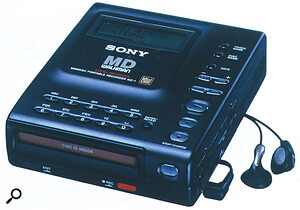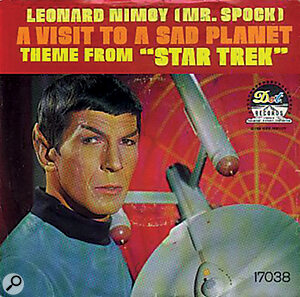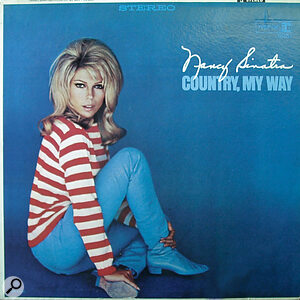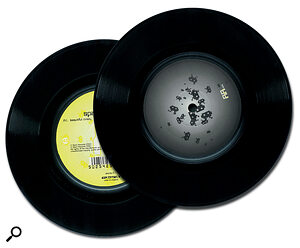The sampler has made its presence felt throughout modern music production, and phrase sampling in particular is the backbone of many musical styles. Oli Bell arms his loop points and explores some tricks of the trade. This is the first article in a three‑part series.
If we drew up a list of the ten most influential pieces of kit over the last couple of decades, it's a pretty safe bet that the sampler would come in at the top, and its influence remains undiminished today. From cheap and portable DJ samplers to powerful 4U rackmount monsters to sophisticated, memory‑hungry virtual machines, samplers are everywhere; essential fixtures in home and professional studios alike.
For many producers, a sampler is no more than a convenient tool for recreating the sounds of acoustic or electronic instruments when it's either impossible or impractical tohave the 'real thing' present in the studio. Careful use of techniques such as multisampling, looping and velocity switching make it possible to produce convincing approximations of anything from a Minimoog to a full orchestra with relative ease. Techniques for doing this successfully have already been covered in depth in previous articles, such as Paul Ward's 'Sampling Analogue Synthesizers' in SOS July 1995 and Dave Stewart's 'Creating Realistic Sample‑based Orchestral Arrangements' in SOS December 1999.
For those artists and producers working within many modern types of music production, however, sampling is less about multisampling and 'realism' and more about phrase sampling — finding individual inspiring samples which can be triggered or looped alongside your track, and manipulated in real time. New styles are often developed on shoe‑string budgets, and so it's hardly surprising that much modern music favours this type of sampling, simply because it tends to place fewer demands on the hardware being used, and hence allows older, cheaper samplers to be pressed into service. So, in the first part of this series, I'll be dealing with the basics of the phrase‑sampling process and suggesting a number of good places to find sounds to sample — while staying on the right side of the law!
Here Comes The Science...
Understanding a little about how the sampling process actually works can be a big help when it comes to getting the best out of your sampler, particularly when you're working with limited sample memory, so let's familiarise ourselves with the basics. A sampler is basically a digital audio recorder, albeit with the ability to fire off the sounds it contains in any order on the fly. Like all digital recorders, it works by using an analogue‑to‑digital (A‑D) converter to take a rapid series of measurements of the voltage level of an audio signal, storing these as numbers, called 'samples', in onboard chip‑based Random Access Memory (RAM). These numbers can then be used to reassemble a very close approximation of the original audio signal for playback.
Higher frequencies in audio require more digital measurements to be taken per second (ie. a higher sampling rate) if they are to be reproduced accurately. In fact, to be specific, the highest frequency that can be reproduced is just under half the stated sampling rate — hence the oft‑quoted 20kHz cutoff for CD‑quality audio, which has a 44.1kHz sampling rate. However, the more often you sample, the faster you use up your valuable sample RAM. What this means for the samplist on a budget is that sounds which have very little high‑frequency content can often be sampled at a reduced sample‑rate to save memory. In particular, basses and kick drums will often not suffer noticeably from having their bandwidth brought down as far as 6 or 8 kHz. Other drum sounds and electric guitars may be brighter, but will still often not have much content over 10 or 12 kHz — some people's hearing range barely extends beyond that...
Another variable that affects how good your samples sound is how many digits are available for storing each measured number — though these are called 'bits' within the binary number system that digital recorders use. The more bits you use per sample (ie. the greater the resolution, or 'bit depth') the more accurately you can distinguish between different audio voltages, and the less the audio signal is distorted by the digital encoding. Because digital distortion of this kind tends to sound something like a cross between SMPTE timecode and white noise, most people use at least CD‑quality 16‑bit resolution when sampling where the aim is realism. However, 16‑bit samples are memory‑hungry, and so lower bit depths are sometimes used to save storage space. This is not as common a practice as reducing sampling rate, however, as the deterioration in the sound quality tends to be far more drastic.
One thing to bear in mind, though, is that musicians using low sampling rates and bit depths as a matter of course have made the type of sound these processes create characteristic of many modern music styles. This means that you might want to experiment with such techniques simply for their characteristic sound, even if you're swimming in spare sample RAM! For example, sampling at 12‑bit resolution can add attractive 'crunch' to drum loops, while reducing bit depth and sampling frequency together can add a nice 'telephone line' distortion to vocal samples.
Getting Practical
 If you use a simple phrase sampler with only a small amount of RAM, such as the Zoom SampleTrak or the Yamaha SU10, you may have to reduce sample rate or bit depth to extend your sampling time.
If you use a simple phrase sampler with only a small amount of RAM, such as the Zoom SampleTrak or the Yamaha SU10, you may have to reduce sample rate or bit depth to extend your sampling time.
Getting sounds into your sampler usually isn't difficult: most modern samplers have standard quarter‑inch jack inputs for connecting to your sound source, be it a microphone, recorder, synth or whatever. Some of the more expensive professional models also have XLR and/or digital inputs, while portable DJ samplers often have only phono inputs for connecting turntables. Recording is usually triggered in one of three ways: manually, by hitting a 'record' button; automatically, when the audio level exceeds a user‑defined threshold setting, which is helpful when sampling drum or percussion intros from vinyl or CD; or via MIDI, using a note message from your controller keyboard, which can be very handy when sampling sounds directly from synths and drum machines.
The main consideration when recording a sample is the level at which the sound source is encoded. Most samplers have adjustable analogue input gain for their recording inputs, and an input level meter of some sort to assess the level at which the signal is reaching the A‑D converters. To get a good, loud sample, adjust the record level until the incoming signal only occasionally touches the highest bar/light of your metering. If you drive the A‑D converters too hard, they will remove the peaks from your signal, resulting in a particularly harsh digital distortion — if you can hear any unwanted distortion, back off the signal level a little until it disappears. Of course, there may be the odd occasion when this distortion actually sounds good, adding some dirt or character to the resulting sample. If it works, use it — there are no rules.
You can also damage the sound‑quality of your samples if you capture them at too low a level — every 6dB of unused headroom when you record a sample effectively reduces the resolution of the recording by one bit, and that can soon add up. Some musicians attempt to remedy the low level by normalising the sample in the digital domain, though the loss of recording resolution can't be rectified in this way. Once again, because many musicians do record at too low a level and make up for it by normalising, this bit‑reduced sound has become desirable in its own right within certain circles. However, it's worth normalising only when you feel there are good sonic reasons to do so, rather than automatically doing it in order to avoid having to optimise record level.
Of course, you don't have to sample directly from source. EQ'ing your samples before recording them is a good way of beefing them up and getting rid of unwanted background sound that may colour your overall mix. Noisy vinyl recordings, for example, can often be improved by cutting the high frequencies and adding a small boost in the high mids. Just bear in mind, though, that any EQ boost you apply may cause the sampler's input to clip, so keep an eye on the input meters.
If you have limited mixer outputs/effects available, try sending your sound through an effects unit before sampling. By recording the sound with effects already in place, you can eliminate the need to process the sample later — though make sure to leave enough space at the end of the sample to avoid cutting short any reverb tails or delays you might use. The downside with recorded effects, though, is that you're stuck with them — if you can, always keep a backup of the dry sample on disk, just in case you need to rerecord your processing when you come to mix.
Stop, Look & Listen
 Sampling inputs vary in quality and format, from balanced XLRs (as on the high‑end Emu E4XT) to unbalanced phonos (as on the budget Akai S20).
Sampling inputs vary in quality and format, from balanced XLRs (as on the high‑end Emu E4XT) to unbalanced phonos (as on the budget Akai S20).
The beauty of samplers is that any sound can be sampled and manipulated. If you can hear it, you can sample it. And if you can sample it you can turn it into something musically useful! This freedom to experiment is fundamental, and yet too many of us overlook it. There is a wealth of untapped musical potential in the sounds going on around us every day, yet it's all too easy to get stuck in the habit of searching the same few sample CDs when you need inspiration for a track.
So let's go back to basics. Grab a mic, plug it into the input of your sampler and start to explore your surroundings. What can you hear: the hum of a computer, the sounds of traffic outside, or that damn squeak your chair makes? What might make a nice sound if tapped, using a drum stick, a chopstick or even a pencil? A half‑drunk mug of tea hit with a chopstick and pitch‑shifted down a few notes begins to sound like a cow bell; pitch the sample up and you have a strange organic hi‑hat. Drop the pitch drastically and it begins to sound like the bells of a lost Tibetan monastery.
The average kitchen holds a massive drum kit ready to be set up and sampled. Experiment with size and shape: Metal cheese‑graters make fantastic percussion sounds when hit and rubbed and the curved shape of a wok makes it surprisingly playable. Remember you don't have to play a riff or beat, just single hits will do, as you can sequence patterns later. Of course, it's not just percussive sounds that can be found lying around the house: I've found that deep synth‑like atmospheres can be created by pitching down samples of a vacuum cleaner or washing machine. If you have children or younger siblings there is a vast array of kids toys to play with (all in the name of your art, of course). Laser guns, talking dolls and 'my first keyboard'‑style instruments can all provide odd noises to sample. Learning aids often produce great synthesised vocals — indeed, the original Speak And Spell can sell for a fair wad of cash in the right circles!
If you find you've exhausted your immediate surroundings then take a look outside. There are a million interesting sounds to be heard right now outside your front door, and for free. If you own a portable DAT, Minidisc or even a cheap dictaphone (Sony's Cassettecorder is a favourite) get out and about and see what sounds you can find. Everyday sounds like those on a crowded train, snippets of conversation on the bus, rain on the car roof, or just the sound of your local pub (as if you need the excuse) can be sampled to provide atmosphere or odd sounds for your tracks.
Think big! Large indoor structures like shopping centres, train stations and car parks all have their own individual acoustics and noises. Hang around for a while and record the ambience. Laying this type of atmosphere low in the mix behind a rhythm track adds depth and interest to your beats — a trick favoured by many hip‑hop producers. Of course, 'real life' samples also work brilliantly as intros and sound effects, so grab a mike and your coat and give it a go — some fresh air will probably do you good!
In reality not everything you sample will produce something which will turn a track around, but with a little effort you can come up with some truly original samples that will be unique to your recordings. And if you liked the ideas above, why not also check out Nick Rowland's 'Creative Sampling' series (SOS December 1998 and January 1999) for other ways to spice up your sampling.
Platters Matter
Perhaps the most popular (and infamous) way in which modern samplists find sounds is by lifting them from old vinyl. Whether taking just a single bass drum kick or editing out a whole bar, raiding the record collection has been fundamental to many styles of modern music production from their very outset. There are plenty of specialised second‑hand record shops that stock rack upon rack of classic vinyl, but don't be fooled into thinking that interesting samples are only to be found on expensive funk 45s. That road has been well travelled and most of the classic breaks and loops have already been done to death.
Unless money is no object, or you are hunting for something specific, forget about the specialists. Instead, take a trip to the local charity shops — you'll probably have three or four in your area. These are great places to buy very cheap vinyl because, although the selection is normally tiny, there are often real bargains to be found. Car boot sales are another good hunting ground. Avoid the trade stalls and go straight for the grubby cardboard boxes just hauled down from the loft — and make sure you get up early to beat the dealers and collectors who will often be circling like vultures trying to beat you to all the best stuff.
Another way you can pick up cheap vinyl is by getting to know your local second‑hand record dealer. The odds are that he buys whole boxes of records to get the few valuable items he wants, so find out what he does with the vinyl he doesn't use — LPs with no covers, for example. This is stuff he may not even bother to go through, let alone try to sell, so if he thinks he can make any money back at all (however little) on these lost causes then you will become very popular, very quickly.
Copyrights & Wrongs
A number of musicians have famously fallen foul of copyright law when sampling things from records without clearing the use of those samples with the copyright owners, so let's be absolutely clear on this point: any sample that originates from another artist's recorded work is subject to copyright law. Long gone are the carefree days of the '80s and early '90s, where the copyright departments of the record industry were caught well and truly by surprise — the back catalogue of artists like James Brown and George Clinton were practically transformed into public property, with loop after loop being lifted and used. Even though the lawyers took a little while to catch up, effective legislation has now been in place for some time.
So what is copyright? According to the UK's Copyright, Designs and Patents Act of 1988 and the US Copyright Act of 1976, copyright is an intellectual property right that is given to the creators of original musical (including lyrics), literary, artistic and dramatic works. Effectively, a piece of music is in copyright from the moment that it is recorded in some material form — this will often be when it's first recorded onto tape or CD, but also applies when it is notated as sheet music. Once a copyright exists it lasts for 70 years after the death of the writer, at which point it normally passes into the public domain, though this is reduced to 50 years in the US.
What all this means to the samplist is that any sample which is used without the permission of the copyright holder is an infringement of the above acts. This includes even tiny samples such as single drum sounds, like kicks and snares. Though, of course, in reality it would prove difficult to trace the origin of a single drum hit, and extremely unlikely that anyone would notice it in the first place, the law still applies. However, the racks of white‑label releases show that many artists choose to fly in the face of this legislation, but they do so entirely at their own risk. If the owner of the copyright prosecuted, they'd have the right to order the artist to 'cease and desist' (stop the pressing and selling of the offending track) as well as having a good case for claiming financial damages. While not everyone gets caught, it could be costly to be found out, so consider that before you take the risk.
In the UK, if you use a sample of someone else's copyrighted song in a new work, clearance must be sought from the following copyright owners:
- The owner of the Music Literary Right (the actual music). This is usually the Composer or Author of the work. Quite often they will assign this right to a publishing company, in which case clearance will then have to be sought from the publisher.
- The owner of the Moral Right (the right to receive label credits where due, and the right to prevent any derogatory use of the work). This operates similarly to the Music Literary Right.
- The owner of the Sound Recording Right (Master Rights). This is the owner of the original recording that is being sampled — usually the investor or company who financed the original recording.
For help in finding the relevant copyright owners' information and their contact details, get in touch with either the PRS (Performing Rights Society) or the MCPS (Mechanical Copyright Protection Society) — in the USA there are a number of such societies, including ASCAP, BMI and SESAC. These organisations can offer helpful advice, but be aware that they cannot negotiate or give clearance for a work to be sampled. Once the copyright owners are established, you should submit a tape containing your track followed by the original work that was sampled and a covering letter containing full release information — including title, writer, publisher, artist, label, number of pressings and release date. The usual agreed terms of usage will include a percentage share of the publishing royalties in the new song and a one‑off fee to the record company for the master rights clearance.
Next Month...
 Portable digital recorders, such as this personal Minidisc unit, are great for collecting new material for sampling, and you can now pick them up at bargain prices.
Portable digital recorders, such as this personal Minidisc unit, are great for collecting new material for sampling, and you can now pick them up at bargain prices.
That's all for now, but look out for next month's instalment, where I'll be helping you choose the best sampler for your needs, and the best sample CDs to go with it.
Sourcing The Raw Material

When you're searching for vinyl and other recordings you might want to sample, bear in mind that great samples often come from the most unlikely of sources. Here are some examples of records you might not have thought to listen through, but which often contain hidden nuggets:
- Spoken‑word and comedy LPs. Often single words or phrases can be taken out of context and used as unusual vocal hooks.
- Self‑tuition & self‑help courses. Whether it's teaching a foreign language, a fitness regime, or yoga, these LPs, cassettes and videos are filled with usable samples.
- Obscure movies. Take away the pictures and you can be left with some really unusual tracks and atmospheres. Look out for foreign films, in particular, or just plain oddities.
- Flexidiscs. Although hard to find, these 45‑sized pieces of floppy plastic can contain anything from obscure band interviews to DIY tips.
- Dodgy covers albums. Covers LP's were a particular craze of the '70s, with TV orchestras or just groups of session players knocking out the current hits. Oddly compelling sampling.
- Kids' LPs. From fairy stories to nursery rhymes, kids' records are a great place to find vocals and odd snippets of music.
- Old demos. Were you or your mates ever in a dodgy band? Dig out any demos or recordings you made and go through them for any usable samples. By turns a painful and rewarding experience.
Playing It Safe

I spoke to Emma Cummant at the MCPS Copyright Department in London, who gives the following advice to samplists:
- Always clear samples before release or commercial exploitation. Apart from being the correct way to proceed and gaining favour from the copyright owners, this strengthens your negotiation powers greatly and will often cost you much less than trying to clear your surprise Top Ten hit at the last minute.
- A sample can be any sound that has been re‑recorded and reproduced in a new format. Clearance must always be sought, and it is a myth that there is any minimum sample duration — if it's in copyright, you have to clear it!
- Sampling is big business nowadays, and most major companies have individuals or whole departments dedicated to sample clearance. This provides great remuneration for companies whose artists/writers are classed as 'lost/old product', so don't be shy to contact them.
- Remember that certain artists don't like to be sampled at all, so always check with the relevant publishers too.
Give Me A Break

There are some records which have been sampled to death, and which are therefore worth a listen to learn how to spot a great potential loop when you hear one:
- James Brown: 'Funky Drummer'
Arguably the most sampled loop of all time. Emerging from a casual studio‑based jam with super funky Clyde Stubblefield on the sticks and the Godfather of Soul in the driving seat. The Funky Drummer loop has been done to death and then some, but always manages to sound great. A classic.
- Michael Vinners Incredible Bongo Band: 'Apache'
A cover of the Jerry Lorden track, most famously twanged by the Shadows, the breakdowns and extended percussion solos are fantastically produced and still hold their own today. Heavily used in every style from drum & bass to hip‑hop, this break was last sighted underpinning the latter half of 'Machete' from Moby's current LP Play.
- The Winstons: 'Amen Brother'
Better known today as just the 'Amen' break, this loop from an up‑tempo Gospel stomper has underpinned the drum & bass scene for years. Still to be found cut up and abused on tracks today, it is a great example of how influential a couple of bars by a talented drummer can be.




